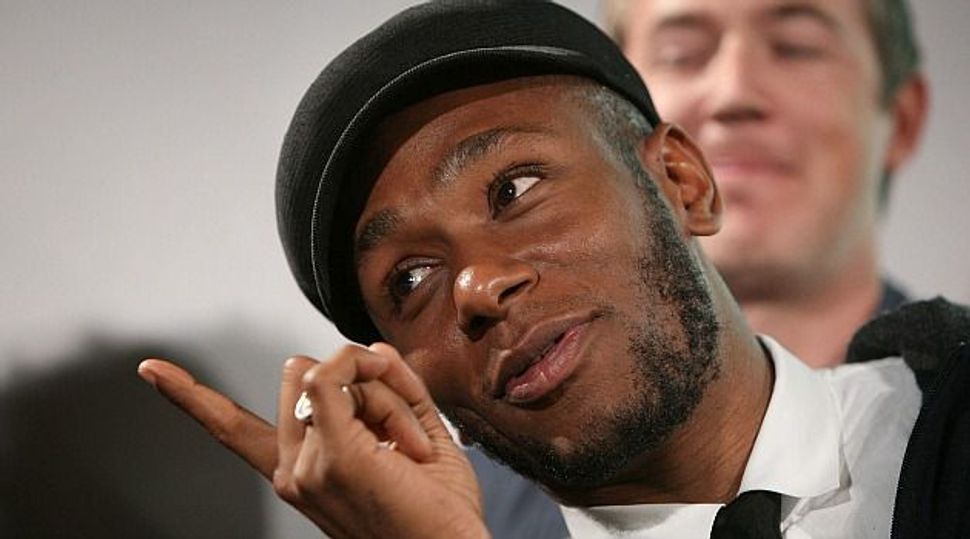Is ‘Yeshivish’ a Language or a Dialect Like ‘Ebonics’ — or Neither?

He?s Def: Rapper Mos Def is eloquent in both standard English and street vernaculary. A major difference between Yeshivish and Black English is that whereas the former diverges from standard English mainly in vocabulary, the latter does so mainly in phonetics and grammar. Image by getty images
In last week’s column, I discussed Sarah Bunin Benor’s recent book, “Becoming Frum,” which dwells largely on the process whereby American Jews who have become religiously Orthodox adjust to the linguistic usages of the Orthodox and ultra-Orthodox communities they have joined. In many respects, as Benor points out, they have to learn to speak a different language, one replete with Hebrew, Yiddish and Aramaic words with which most American Jews, let alone non-Jews, are unfamiliar.
But is “Yeshivish,” as this form of Judeo-English is commonly referred to, really a different language from a linguistic point of view, or is it merely a peculiar form of English? Is its relationship to English comparable to that of Yiddish to German, which are two closely related but nevertheless distinct languages, or is it more like the relationship of the several (and now largely extinct) varieties of Judeo-Italian to their regional Italian counterparts, which is simply one of dialectal divergence?
It’s a complicated question, in part because linguists do not have a simple way of determining what distinguishes a separate language from a dialect. Take, for instance, the oft-used criterion of mutual intelligibility, according to which two separate languages exist when the speakers of one cannot understand those of another, while two dialects of one language exist when their speakers can understand each other, but only with some effort.
If we applied this criterion, we would arrive at the not very startling conclusion that French and English, or Turkish and Greek, are different languages. We would also, however, be forced to conclude that Danish, Swedish and Norwegian are dialects of the same language; that Polish, Czech, Russian and Ukrainian sometimes are and sometimes aren’t, and that what we call Chinese is actually the five different languages of Mandarin, Wú, Min, Hakka and Yué.
Moreover, it’s not uncommon to find two forms of speech in which the speakers of Form A understand, partly or wholly, those of Form B, but not vice versa. Yiddish speakers can often understand German, whereas German speakers can rarely understand Yiddish, and while I may have great difficulty following a conversation in the “Black English” of two African Americans, no African American will find it hard to follow a conversation between two white Americans like me.
Is Black English a separate language or a dialect? Arguments have been made for both points of view.
The separate-language advocates point to Black English’s unique features, which can make it incomprehensible to a speaker of Standard English. The dialect proponents observe that a speaker of Standard English can learn these features very quickly, and that Standard English is understood by all speakers of Black English and spoken by most of them.
To this, in turn, comes the reply that this is so only because Black English speakers are exposed to Standard English from infancy through television, in schools and so on, and that if they weren’t, they would understand it no better than Standard English speakers understand them.
The case with Yeshivish is similar. One can compose no end of sentences in it to which the average American wouldn’t have a clue. When an American-born mother says to her misbehaving birthday child, using Hebrew and Yiddish words that are part of her daily speech, “Yankele, if khas v’sholem you make a shande you won’t be zoykhe to have your simkhe” few non-Yeshivish speakers would know she is telling him that if, God forbid, he makes a scene, he won’t be entitled to his party. Yet the same mother understands standard English perfectly and can speak it flawlessly whenever she has to.
A major difference between Yeshivish and Black English is that whereas the former diverges from Standard English mainly in vocabulary, the latter does so mainly in phonetics and grammar.
When an inner-city African-American (the example comes from J.L. Dillard’s “Black English”) says, “Her paintin’ wif a spoon,” meaning, “She is painting with a spoon,” the words used are all Standard English ones; the way they are pronounced and put together is not. In our example of Yeshivish, on the other hand, its nonstandard features are entirely lexical, while the grammar and pronunciation of its English words are ordinary.
In the end, the debate is a semantic one: Define “dialect” and “language” for me, and I’ll tell you which of the two Norwegian, Wú or Yeshivish is. When the renowned Yiddish linguist Max Weinreich once quipped that “a language is a dialect with an army and navy,” he wasn’t being entirely facetious, and Yeshivish is certainly armyless and navyless, although, as Weinreich was only too ruefully aware, Yiddish was, too. But one way or another, the fact is that under our very noses, a new Judeo-English is being created in America that, for the time being, shares some things with Yiddish but not others and has characteristics of both a language and a dialect. It will be fascinating to watch it develop.
Questions for Philologos can be sent to [email protected]























